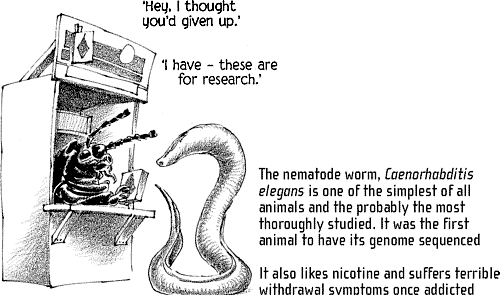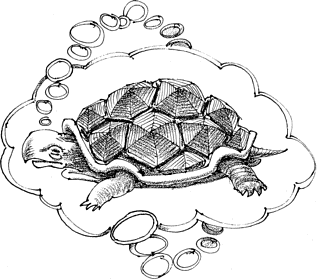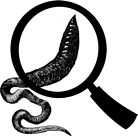The Book of Animal Ignorance (35 page)
Read The Book of Animal Ignorance Online
Authors: Ted Dewan

T
he animal kingdom is subdivided into thirty-four categories called phyla. There is some disagreement among biologists about the precise number and placing of the divisions, but everyone agrees that more than half of them (usually seventeen) are made up of various kinds of worm. There may be more species of beetle, but there are more individual worms in the world than any other type of creature. No matter how many cattle there are in a field, the worms under the soil will always outweigh the cows on top of it.
Nematodes, or roundworms, are parasitic worms found almost everywhere on earth from the ocean floor to the human gut. They are the most numerous animals on the planet, ranging from a hundredth of an inch to 27 feet long. There are about 40,000,000,000,000,000,000,000,000,000,000,000,000,000, 000,000,000,000,000 nematodes all told and their DNA is 75 per cent identical with that of human beings. Most nematodes are benevolent, humbly servicing the ecosystem, but some are dangerous parasites that can cause river blindness, elephantiasis and hookworm anaemia. Then there are flatworms and segmented worms, spoon worms and peanut worms, ribbon worms and horsehair worms. Velvet worms live in old leaves and rotting logs. They paralyse animals and liquidise them with saliva. Acorn worms live in U-shaped burrows on the seabed. They eat and excrete mud. Those little coils you see on the beach at low tide are acorn worm droppings. All worms except paddle-worms are hermaphrodites.
Pseudoceros bifurcens
is a flatworm that lives 60 feet underwater in Queensland, Australia. It performs a mating dance called âpenis-fencing'. The worms spend up to an hour trying to inject each other with sperm: whoever wins gets to be the male. Ribbon worms will eat their own bodies if their food supply runs out. They can eat up to 95 per cent of themselves and still survive.
It may be doubted
whether there are
any other animals
which have played
so important a
part in the history
of the world, as
have these lowly
creatures
.
CHARLES DARWIN
Lewis Carroll said he liked worms âbecause nobody else does' but Charles Darwin was also a huge admirer. He spent days counting earthworms in his garden while his son played the bassoon to them. There are 3,000 species of earthworm, ranging from 2 inches to 11 feet long. Good soil contains a million earthworms per acre. A typical earthworm has no lungs, teeth or eyes but it has ten hearts, arranged in five pairs. Though they are eyeless, their skin detects changes in light. Their simple brains are used merely to tell their bodies how to react to these changes. If you removed an earthworm's brain, you wouldn't notice much change in its behaviour. The sex organs of an earthworm are located in the clitellum, the bulge a third of the way from the front of the worm that looks like a rubbery armband. The word is from the Latin
clitellae
, a packsaddle. Earthworms mate by lying next to each other, head to tail. Both secrete mucus until each is enclosed in a slime tube, after which they exchange sperm and eggs. Earthworms are essential to life, because they aerate the soil, enabling plants to grow â without them, we'd all starve in short order. Cleopatra declared earthworms sacred: removing one from Egypt was an offence punishable by death. It's still legal to play the bassoon to them, however.
THE MODEL NOSE

T
he philosopher William James once wrote that a crab would be âfilled with a sense of personal outrage' if it could hear us class it as a crustacean. âI am no such thing,' it would say. âI am MYSELF, MYSELF alone.' With that in mind, we'd like to be able to declare that no animal has been intentionally insulted, misrepresented or traduced in the making of this book.
It is the product of much research by many people, and the only reason we haven't listed this is aesthetic â it would make it look and feel like a very different kind of book. If you would like information on our sources, or to correct or add to the information we have gathered, we would love to hear from you at www.qi.com/animalignorance
All mistakes are our own; all the best information has come from real scientists like Dr Joseph Garner at Purdue Unviersity, or the indefatigable efforts of the QI Elves. Special mention must go to Piers Fletcher, Justin Pollard, Garrick Alder, Xander Cansell, Vitali Vitaliev and to the regular members of the QI Talkboard who operate like an intellectual SWAT team, always on hand with original research and wise advice. Particular thanks are due to suze and dr. bob.
We'd also like to thank Stephen Page, Julian Loose, David
Watkins and the team at Faber for their faith and patience; Paula Turner for her keen editorial eye and linguistic sure-footedness; and Sarah Chaloner, Beatrice Gray, and Lorraine Heggessy at Talkback Thames TV: this isn't much of a TV tie-in, but they helped make the space in which it was written.
Finally, thanks to Rachael, Sarah and Helen who have listened, advised, foraged, nurtured, and generally kept the kinship groups going while we hunted.

All the thoughts of a turtle
are turtle
.
RALPH WALDO EMERSON
The Book of General Ignorance
Also by John Lloyd (with Douglas Adams)
The Meaning of Liff
The Deeper Meaning of Liff
Also illustrated by Ted Dewan
Inside the Whale and Other Animals Inside Dinosaurs and Other Prehistoric Animals The Evolution of Consciousness Wild Minds
About QI
QI is short for Quite Interesting. Although best known as a BBC panel game, that is really just a front for a band of rather polite revolutionaries who are dedicated to the overthrow of boredom in our culture by creating books, TV programmes and games that celebrate curiosity, discovery and humour, rather similar to the one you are holding.
If you fancy a wallow in Interestingness, join the QI elves at www.qi.com
John Lloyd
is the founder of QI and the producer of some of Britain's best-loved TV shows. He lives with several cats, four mice and a tub of well-endowed brine shrimps.
John Mitchinson
is Director of Research for QI and shares his life with pigs, chickens and a rather malodorous animal who answers to the name of âMr Ferret'.
Ted Dewan
is possibly the UK's only cult children's author and illustrator. He keeps no livestock but did invent
Crispin the Pig Who Had It All and Bing Bunny
.
First published in 2007
by Faber and Faber Limited
Bloomsbury House
74â77 Great Russell Street
London
WC1B 3DA
This ebook edition first published in 2008
Consultant Editor
Christopher Gray
Researchers
James Harkin
Mat Coward
Jenny Doughty
Molly Oldfield
Justin Gayner
All rights reserved
© QI Ltd, 2007
Illustrations © Ted Dewan, 2007
Clipart images courtesy of Clipart ETC, an online service from Florida's Educational Technology Clearinghouse (http://etc.usf.edu/clipart) and The Pepin Press
The right of QI Ltd to be identified as authors of this work has been asserted in accordance with Section 77 of the Copyright, Designs and Patents Act 1988
This ebook is copyright material and must not be copied, reproduced, transferred, distributed, leased, licensed or publicly performed or used in any way except as specifically permitted in writing by the publishers, as allowed under the terms and conditions under which it was purchased or as strictly permitted by applicable copyright law. Any unauthorised distribution or use of this text may be a direct infringement of the author's and publisher's rights, and those responsible may be liable in law accordingly.
ISBN 978â0â571â24917â6 [epub edition]
